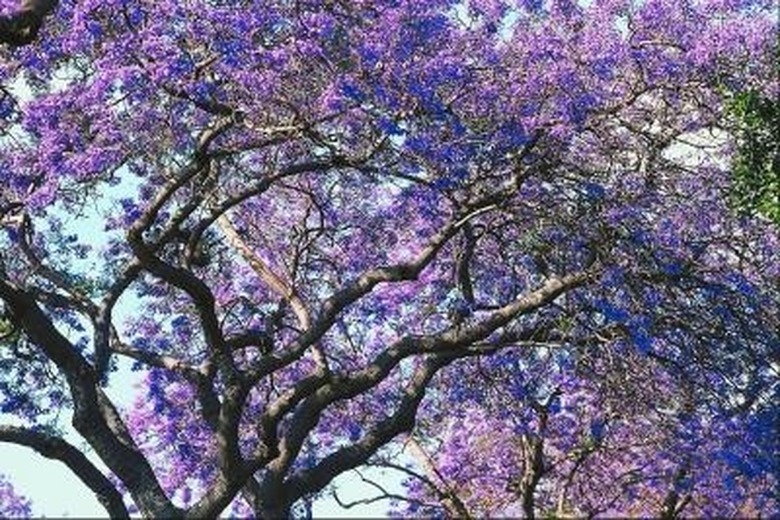Trees With Purple Bell-Shaped Flowers
Flowering plants and shrubs add bursts of color to the garden. However, flowering trees make an even bolder color statement. Only a few species of trees produce purple flowers, but the addition of just one can be beautiful in you landscaping. Always choose trees that are suited to your climate.
Jacaranda
One of the best known purple-flowered trees is the jacaranda. The jacaranda tree is a deciduous tree with fern-like leaves, but its most distinctive feature is its mass of bright purple bell-shaped flowers the cover the tree from April to August. At the end of the season, the fallen blooms create a blanket of purple around the base of the tree. Jacarandas can reach 25 to 40 feet tall and prefer the warm temperatures and mild weather of the tropical and sub-tropical climates in zones 9 through 11.
Pawpaw
The pawpaw tree is native to the United States and tolerates the cold winters of the temperate climate found in zone 5 states Illinois, Indiana and Ohio through to the hot, humid summers of zone 7 states Arkansas, Tennessee and Alabama. The broad bell-shaped flowers of the pawpaw are a rich, purple brown color and produce pawpaw fruit that tastes like a combination of banana and mango or peach. The trees only grow between 12 and 20 feet tall and do not transplant well.
Purple Catalpa
The purple catalpa tree adds a double splash of purple to the landscape. The leaves on this deciduous tree are a dark purple when young, maturing to a dark green. The upright clusters of bell-shaped flowers are white but have purple markings. The 50-foot tall trees like sun and partial shade and are hardy to zone 5.
Princess Tree
Paulownia tomentosa, also known as the princess tree or empress tree, is a native of China grown as an ornamental in the United States. This deciduous tree has large heart-shaped leaves and large showy clusters of fragrant bell-shaped purple flowers that form in autumn to bloom in early spring. The princess tree is hardy to zone 5, need protection from wind and can grow to 40 feet tall.
Crape Myrtle
The crape myrtle is a small, summer-flowering deciduous tree. The large showy clusters of flowers may be different shades of white, red, pink or purple. Although the flowers of this low-maintenance southern beauty aren't highly fragrant, its appearance has led to the nickname the lilac of South. Trees range from 10 to 30 feet tall.
References
- University of Florida IFAS Extension; Jacaranda Mimosifolia — Jacaranda; Edward F. Gilman, et al.; May 2011
- Virginia Tech: Pawpaw
- Oregon State University Extension; Purple Catalpa
- Clemson Cooperative Extension; Crape Myrtle; Debbie Shaughnessy, et al.; November 2006
- University of Florida IFAS Extension; Paulownia Tomentosa — Princess-Tree; Edward F. Gilman, et al.; May 2011
